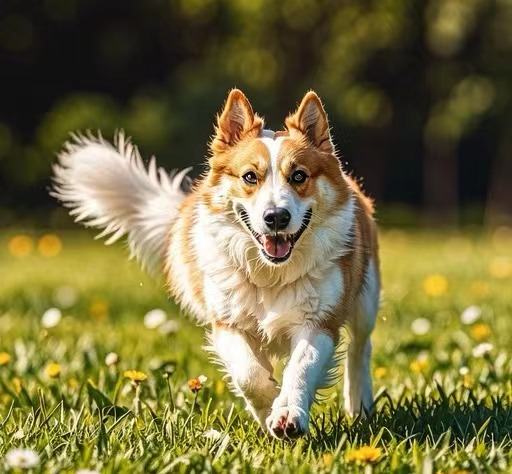
by TCMVET | May 9, 2024 | Dog Cancer & Tumors
Cancer remains one of the most formidable health challenges in dogs, but understanding the disease and adopting preventive measures can significantly improve the quality of life and longevity of our canine companions. This article explores critical strategies for preventing canine cancer and supportive measures for dogs diagnosed with the condition.
Understanding Canine Cancer: A Brief Overview
Cancer in dogs, similar to humans, involves the uncontrolled growth of cells that can affect any part of the body. The most common types include lymphoma, melanoma, mammary cancer, and bone cancer. Early detection and appropriate treatment are crucial in managing this disease effectively.
Preventive Measures to Reduce Cancer Risk
Diet and Nutrition: A balanced diet rich in antioxidants can help reduce inflammation and prevent cancer. Foods that are high in vitamins E and C, beta-carotene, and omega-3 fatty acids are especially beneficial. Consider incorporating fresh, whole foods like blueberries, carrots, and leafy greens into your dog’s diet.
Regular Exercise: Regular physical activity not only helps maintain a healthy weight but also reduces the risk of cancer. Exercise boosts the immune system and helps eliminate toxins through increased metabolic activity.
Avoid Carcinogens: Minimize your dog’s exposure to known carcinogens such as tobacco smoke, certain pesticides, and toxic household chemicals. Use natural cleaning products and ensure that your dog’s environment is as toxin-free as possible.
Routine Veterinary Check-ups: Regular check-ups can help detect cancer early. Veterinarians can perform routine screenings for lumps, abnormal swellings, or symptoms that could indicate the onset of cancer.
Supporting a Dog Diagnosed with Cancer
Optimal Diet: Adjust your dog’s diet to support cancer treatment. Diets high in protein and low in carbohydrates can starve cancer cells and slow their growth. Consult with a veterinary nutritionist to tailor a diet plan that’s best for your dog’s specific type of cancer.
Pain Management: Effective pain management is crucial. Your veterinarian can recommend medications to alleviate pain, improve quality of life, and support overall well-being.
Alternative Therapies: Consider complementary therapies such as acupuncture, massage, or herbal supplements that may provide additional support alongside conventional treatments like chemotherapy or radiation.
Emotional Support: Beyond physical care, emotional support plays a vital role in the health of a dog with cancer. Provide a comfortable, stress-free environment and spend quality time with your pet to help them feel loved and secure.
The Importance of Hope and Care
While a cancer diagnosis can be daunting, advancements in veterinary medicine have made it a manageable condition in many cases. With the right strategies and compassionate care, dogs with cancer can lead fulfilling lives.
Implementing these guidelines can significantly aid in both preventing and managing canine cancer. Owners are encouraged to work closely with their veterinarians to tailor prevention and treatment plans that best suit their pets’ needs.

by TCMVET | May 8, 2024 | Dog Cancer & Tumors
Turkey tail mushrooms (Trametes versicolor) have emerged as a powerful natural treatment in the battle against canine cancer. This article explores the unique properties of turkey tail mushrooms, their role in enhancing a dog’s immune system during cancer therapy, and practical advice for incorporating them into your pet’s regimen.
What are Turkey Tail Mushrooms?
Turkey tail mushrooms are a type of fungus renowned for their distinctive, colorful, fan-like shape. They are abundant in bioactive compounds, such as beta-glucans, which are known to boost immune responses and potentially counteract the growth of cancer cells.
Immune System Enhancement
The primary benefit of turkey tail mushrooms lies in their ability to modulate the immune system. They increase the production of immune cells like macrophages and lymphocytes, which are crucial for detecting and destroying cancerous cells. This makes them an excellent adjunct therapy for dogs undergoing traditional cancer treatments such as chemotherapy or radiation.
Anti-Cancer Properties
Beyond immune support, turkey tail mushrooms contain compounds that directly combat cancer. Research has indicated that the natural phenols and flavonoids present in turkey tail mushrooms have antioxidant properties that help reduce cellular damage from free radicals, a common issue in cancerous cells.
Incorporation into Canine Diets
Turkey tail mushrooms can be administered to dogs in various forms, including powdered supplements, capsules, or tinctures. When introducing turkey tail into your dog’s diet, start with small doses to assess tolerance and gradually increase to the recommended dose based on your dog’s weight and health condition.
Veterinary Oversight and Dosing
It is vital to consult with a veterinarian experienced in integrative medicine before adding any new supplement to your dog’s cancer treatment plan. A professional can provide guidance on appropriate dosing and ensure the supplement does not interfere with other treatments.
Quality and Purity in Supplements
When choosing a turkey tail supplement, opt for products that guarantee high purity and are free from contaminants. Products should ideally be certified organic and produced by reputable manufacturers who specialize in medicinal mushrooms.
Turkey tail mushrooms offer a promising complementary treatment for dogs with cancer, thanks to their immune-boosting and anti-cancer properties. By enhancing the body’s natural defenses and providing additional antioxidant support, they can be a valuable part of a holistic cancer treatment plan. Always remember to work closely with your veterinarian to tailor the approach to your dog’s specific needs and health status, ensuring the safest and most effective use of this natural therapy.

by TCMVET | May 8, 2024 | Dog Cancer & Tumors
当心爱的狗狗被诊断出患有癌症时,每个宠物主人都会想办法减轻宠物的痛苦,提高它们的生活质量。营养在控制疾病和支持接受癌症治疗的狗狗的整体健康方面起着关键作用。本文探讨了专门针对患癌狗狗的营养需求而量身定制的有效饮食策略。
Boosting Caloric Intake with Healthy Fats
Dogs with cancer often experience weight loss and may have less appetite. Providing a diet rich in healthy fats can help increase caloric intake and maintain energy levels. Foods like fish, chicken thighs, and small amounts of olive or coconut oil can be beneficial. These fats are not only high in calories but also easier to digest, making them ideal for dogs struggling with decreased appetite.
Moderate to High Levels of High-Quality Protein
Maintaining muscle mass is crucial for dogs with cancer. Diets with moderate to high levels of high-quality protein help support muscle repair and immune function. It’s important to choose proteins that are easy to digest and less taxing on the body, such as cooked eggs, cottage cheese, and lean meats. Adjust protein sources and amounts based on your veterinarian’s recommendations to suit your dog’s specific health status.
Low Glycemic Index Carbohydrates
While reducing carbohydrate intake is generally advised, choosing the right type of carbohydrates is also vital. Low glycemic index carbohydrates such as sweet potatoes and pumpkin can provide energy without rapidly elevating blood glucose levels. These carbs help sustain energy slowly and steadily, which is better for maintaining the health of a dog with cancer.
Incorporating Anti-inflammatory Ingredients
Chronic inflammation can exacerbate cancer, so incorporating anti-inflammatory ingredients into your dog’s diet can be beneficial. Turmeric, which contains curcumin, has notable anti-inflammatory properties and can be added to food in small amounts. Other anti-inflammatory foods include celery, bok choy, and small amounts of ginger.
Hydration and Electrolyte Balance
Hydration is especially important for dogs with cancer, as they can easily become dehydrated due to treatment side effects. Ensure your dog has continuous access to fresh water and consider adding electrolyte solutions if recommended by your veterinarian. This helps maintain vital organ functions and overall health.
Customized Nutritional Plans from Veterinary Nutritionists
Considering the varied responses dogs can have to cancer, consulting a veterinary nutritionist to create a customized diet plan can be extremely advantageous. A tailored diet can address your dog’s specific type of cancer, treatment regimen, and individual dietary tolerances, optimizing their ability to fight the disease and maintain a better quality of life.
A thoughtfully chosen diet can make a significant difference in the management of a dog with cancer. Key strategies include increasing caloric intake through healthy fats, ensuring adequate high-quality protein, selecting low GI carbohydrates, reducing inflammation, and maintaining hydration. Above all, regular consultations with your veterinarian or a specialized veterinary nutritionist are essential to adapt dietary strategies to your dog’s evolving health needs. This proactive approach not only supports your dog’s physical health but also their spirits during their fight against cancer.

by TCMVET | May 7, 2024 | Dog Cancer & Tumors
The diagnosis of cancer in dogs often leads pet owners to seek various treatment options, including homeopathic remedies and nutritional supplementation. Understanding the potential benefits and applications of homeopathic cancer treatments alongside the use of vitamin tablets can provide dog owners with additional strategies to support their pet’s health and well-being. This article delves into these complementary approaches, exploring their effectiveness and how they can be integrated into a dog’s cancer care plan.
1. Homeopathic Remedies for Canine Cancer
Homeopathy operates on the principle that “like cures like” and uses highly diluted substances to treat various ailments. In the context of canine cancer, homeopathic remedies are chosen based on the individual symptoms and characteristics of the dog. Common remedies include:
- Arsenicum Album: Used for dogs with general weakness and exhaustion, often beneficial for those experiencing nausea and digestive issues.
- Conium Maculatum: Helpful in cases of glandular tumors and symptoms of aging.
- Thuja Occidentalis: Often used for growths stemming from vaccinations or other puncture wounds.
It is crucial to consult with a veterinarian who has experience in homeopathy to determine the most appropriate remedies based on the specific condition of the dog. Homeopathy can sometimes help manage symptoms and improve quality of life, but it should not replace conventional cancer treatments.
2. Vitamin and Mineral Supplements for Dogs with Cancer
Supplementation with vitamins and minerals can play a critical role in supporting a dog undergoing cancer treatment. Key supplements include:
- Vitamin C: An antioxidant that can help reduce inflammation and potentially combat cancer cell growth.
- Vitamin E: Known for its antioxidant properties, which protect cells from damage.
- B-Complex Vitamins: Essential for energy production and maintaining a healthy metabolism.
Vitamin tablets can help fill nutritional gaps in a dog’s diet, especially when their appetite might be affected by cancer or its treatments. Always discuss with your vet before starting any supplements, as they need to be properly balanced with the dog’s overall diet and health status.
3. Integrating Homeopathic and Vitamin Therapies
Integrating homeopathic remedies and vitamin supplementation can be a holistic approach to supporting a dog’s health during cancer treatment. This integrative strategy should be tailored to the individual dog, considering their specific health needs and the progression of their disease.
Homeopathic cancer treatments and vitamin supplements for dogs offer a more natural approach to support and manage health during cancer. While not substitutes for traditional treatments, when used under the guidance of experienced professionals, these methods can contribute to a comprehensive care plan that supports the overall well-being and quality of life of dogs with cancer. It’s essential to work closely with your veterinarian to ensure these treatments are used safely and effectively as part of your dog’s cancer therapy.

by TCMVET | May 7, 2024 | Dog Cancer & Tumors
In the realm of veterinary care, the increasing prevalence of cancer in dogs has prompted a surge in exploring alternative and natural treatment options. Natural cancer treatments offer a holistic approach, potentially improving quality of life and supporting traditional therapies. In this article, we will delve into some promising natural strategies for managing canine cancer, emphasizing the importance of integrating these with conventional treatments under veterinary guidance.
1. Diet and Nutrition
Nutrition plays a pivotal role in canine cancer care. A diet rich in antioxidants, such as vitamins C and E, can help combat free radicals and reduce oxidative stress, a contributor to cancer progression. Consider incorporating foods like blueberries, spinach, and carrots, which are safe and beneficial for dogs. High-quality protein sources, like lean meats and fish, support immune function and muscle maintenance. Omega-3 fatty acids, found in fish oils, have anti-inflammatory properties that can help mitigate inflammation associated with cancer.
2. Herbal Remedies
Several herbs have been noted for their potential anti-cancer properties. Milk thistle supports liver health, crucial for dogs undergoing chemotherapy. Turmeric, containing the active compound curcumin, is renowned for its anti-inflammatory and antioxidant effects. However, it’s essential to consult with a veterinary herbalist, as some herbs can interfere with conventional cancer treatments.
3. Acupuncture
Acupuncture is increasingly used in veterinary oncology. This traditional Chinese medicine technique may help alleviate pain and improve overall well-being in dogs with cancer. By stimulating specific points on the body, acupuncture can enhance blood circulation, relieve muscle tension, and stimulate nerve release of endorphins and other pain-relieving chemicals.
4. Supplements
Supplements can also play a supportive role in natural cancer care. For instance, medicinal mushrooms such as Reishi and Shiitake have been studied for their immune-boosting and anti-cancer properties. CBD oil is gaining attention for its ability to help manage pain and anxiety in cancer-stricken dogs. As with all supplements, it’s crucial to discuss their use with your veterinarian, as they need to be carefully integrated with other treatments.
5. Physical Therapy and Exercise
Maintaining physical activity is important for dogs with cancer. Exercise tailored to the dog’s condition can help maintain muscle mass, improve mood, and boost overall health. Physical therapy can also include massage and hydrotherapy, which are excellent for keeping your dog’s body as healthy as possible during their cancer treatment.
Natural treatments for cancer in dogs focus on supporting the body’s inherent healing abilities and improving the quality of life. While these treatments are not cures, they can significantly contribute to a comprehensive cancer care plan. Always consult your veterinarian or a specialist in veterinary oncology to tailor the best treatment combination for your furry friend’s specific needs. Integrating natural and conventional treatments holds the promise of providing the best possible care for dogs facing cancer.






